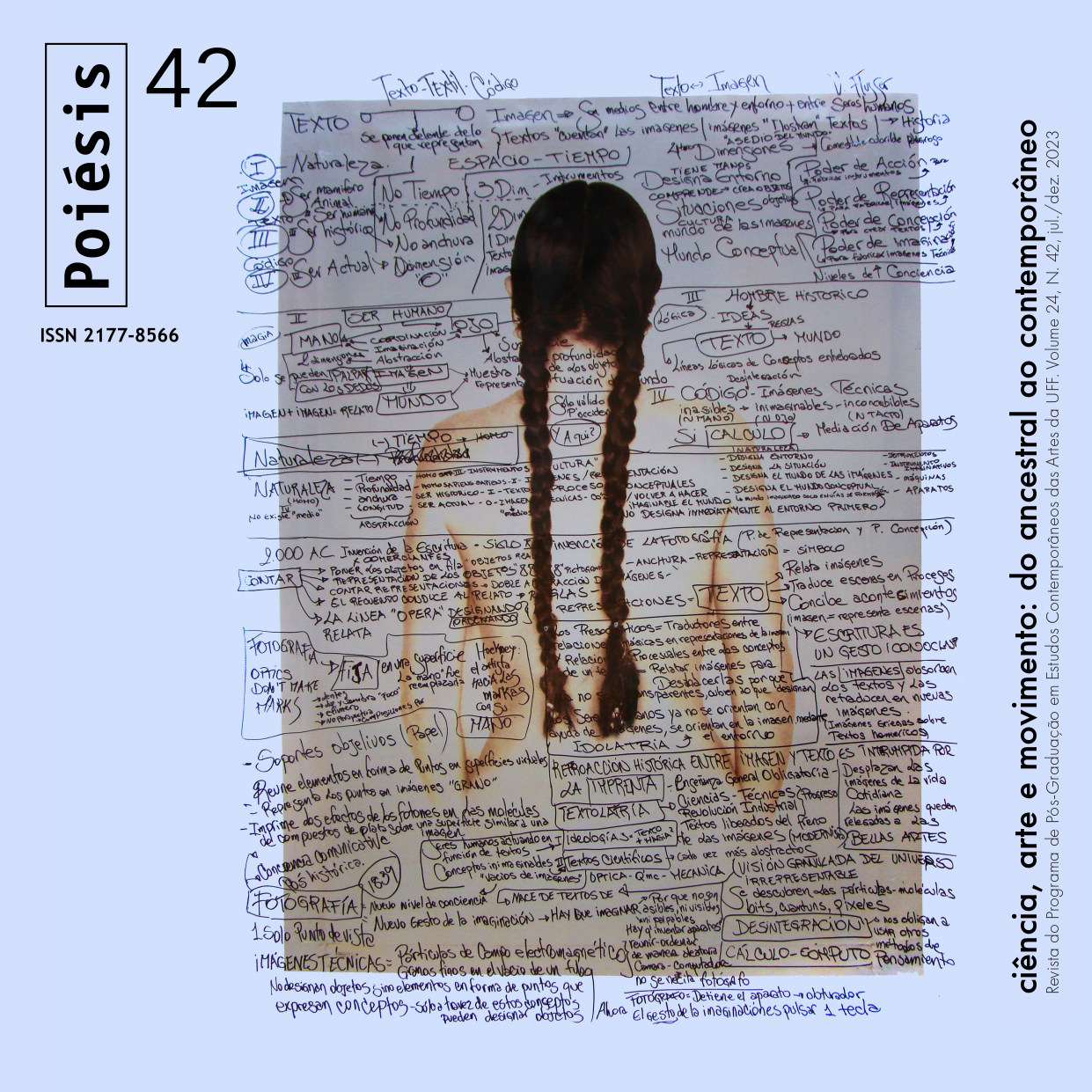ENTRE RECUSAS E INVENÇÕES SE FAZ O MODERNO
O CASO DOS APARELHOS CINECROMÁTICOS
DOI:
https://doi.org/10.22409/poiesis.v24i42.61290Keywords:
Abraham Palatnik, Brazil, Modernity, KinetAbstract
The paper traces the beginning of production of the Kinechromatic Devices, by Abraham Palatnik, in 1951 until his participation in the Venice Biennale in 1964. We reflect on force fields that acted in the discussion on the development of abstract art in Brazil in the 1950’s. The negative reviews and recognition by this kinetic artist expose the clashes about the new in art as well as the constitution of an idea of the modern in Brazilian visual arts. It is discussed the fact that the construction of this field, in particular Palatnik’s work, also goes through a complex network governed by ambiguities such as recognition and refusal; improvisation and Science; celebration and contestation.
Downloads
References
ARANTES, Otília. Apresentação. In: ARANTES, Otília. (org).
Modernidade cá e lá: textos escolhidos IV. São Paulo:
Edusp, 2000. p. 11-23.
ARTE deve influir sobre o homem contemporâneo. Tribuna da
Imprensa, Rio de Janeiro, 20-21 nov. 1954, p. 4.
BARCINSKI, Fabiana Werneck. Perfil biográfico. In:
OSORIO, Luiz Camillo. Abraham Palatnik. São Paulo: Cosac
Naify, 2004. p. 95-111.
BENTO, Antonio. A máquina de Abrahão Palatnik. Diário
Carioca, Rio de Janeiro, 31 out. 1951, p. 6.
BENTO, Antonio. O aparelho de Abraham Palatnik. Diário
Carioca, Rio de Janeiro, 7 nov. 1953, p. 6.
BIENAL DE SÃO PAULO 6, 1961, São Paulo. Catálogo. São
Paulo: Museu de Arte Moderna, 1961.
BRAGA, Rubem. Abraham Palatnik pinta com luz e
movimento. Manchete, Rio de Janeiro, 14 mar. 1953, n.p.
COCCHIARALE, Fernando; GEIGER, Anna Bella.
Abstracionismo geométrico e informal: a vanguarda
brasileira nos anos 50. Rio de Janeiro: Funarte, 1987.
CUNHA, Eilen M. F. Grupo Frente e o experimentalismo
emergente de Lygia Pape, Lygia Clark e Hélio Oiticica, Arte
& Ensaios, v. 1, n. 1, n.p., jun. 1994. Disponível em: https://
revistas.ufrj.br/index.php/ae/article/view/54134/29582
Acesso em: 10 jun. 2020.
JORDÃO, Vera Pacheco, Coluna de Artes Plásticas, O
Globo, Rio de Janeiro, ed. vespertina, 22 jun. 1964, p. 21.
MAURÍCIO, Jayme. Brasileiros no exterior. Correio da
Manhã, Rio de Janeiro, 15 jan. 1965. 2o Caderno, p. 2.
MAURÍCIO, Jayme. Palatnik em St. Gall. Correio da Manhã,
Rio de Janeiro, 20 nov. 1964. 2o Caderno, p. 2.
MAURÍCIO, Jayme. Palatnik, um jovem fascinado pela
luz, Correio da Manhã, Rio de Janeiro, 13 jan. 1953. 1o
caderno, p. 11.
PALATNIK, Abraham; SCOVINO, Felipe. Entrevista. In:
PALATNIK, Abraham; SCOVINO, Felipe. Abraham Palatnik: a
reinvenção da pintura. São Paulo: APC, 2017. p. 42-55.
PEDREIRA, Fernando. Lazar Segall fala de pintura. Diário de
Notícias, Rio de Janeiro, 17 mai. 1953. Suplemento Literário, p. 5.
PEDROSA, Mário. A coleção do Museu de Arte Moderna,
Tribuna da Imprensa, Rio de Janeiro, Tribuna das Letras, 15 jan.
, n.p.
PEDROSA, Mário [?]. A mágica de Palatnik: luz no lugar da tinta,
Tribuna da Imprensa, Rio de Janeiro, 05 nov. 1951, p. 3.
PEDROSA, Mário. A plástica cinemática de Abraão Palatnik.
Jornal do Brasil, Rio de Janeiro, [1958]. Suplemento Dominical, n.p.
PEDROSA, Mário. Arte ambiental, arte pós-moderna, Hélio Oiticica
(1966). In: ARANTES, Otília (org). Acadêmicos e modernos: textos
escolhidos III. São Paulo: Edusp, 1998. p. 355-360.
PEDROSA, Mário. Intróito a Bienal. Tribuna da Imprensa, Rio
de Janeiro, 20-21 out. 1951, p. 7.
Downloads
Published
Versions
- 2024-03-12 (2)
- 2023-12-30 (1)
How to Cite
Issue
Section
License
Copyright (c) 2023 Felipe Scovino

This work is licensed under a Creative Commons Attribution-NonCommercial-NoDerivatives 4.0 International License.
Authors who publish in Revista Poiésis agree to the following terms:
- The authors keep the copyright and grant the journal the right of first publication. The work is automatically licensed under the Creative Commons Attribution License, which enables its sharing as long as the authorship and initial publication in this journal are acknowledged.
- Authors are allowed and encouraged to distribute online their work published in Revista Poiésis (in institutional repositories or in their own personal page), since this can generate productive interactions, as well as increase the impact and citation of the published work (See The Effect of Free Access).


